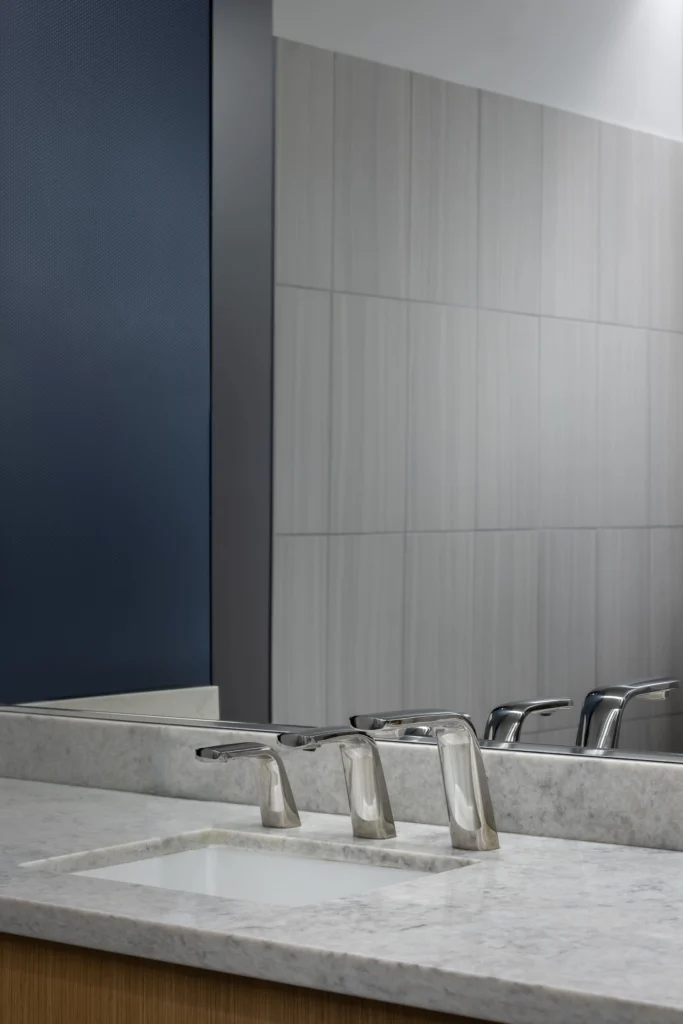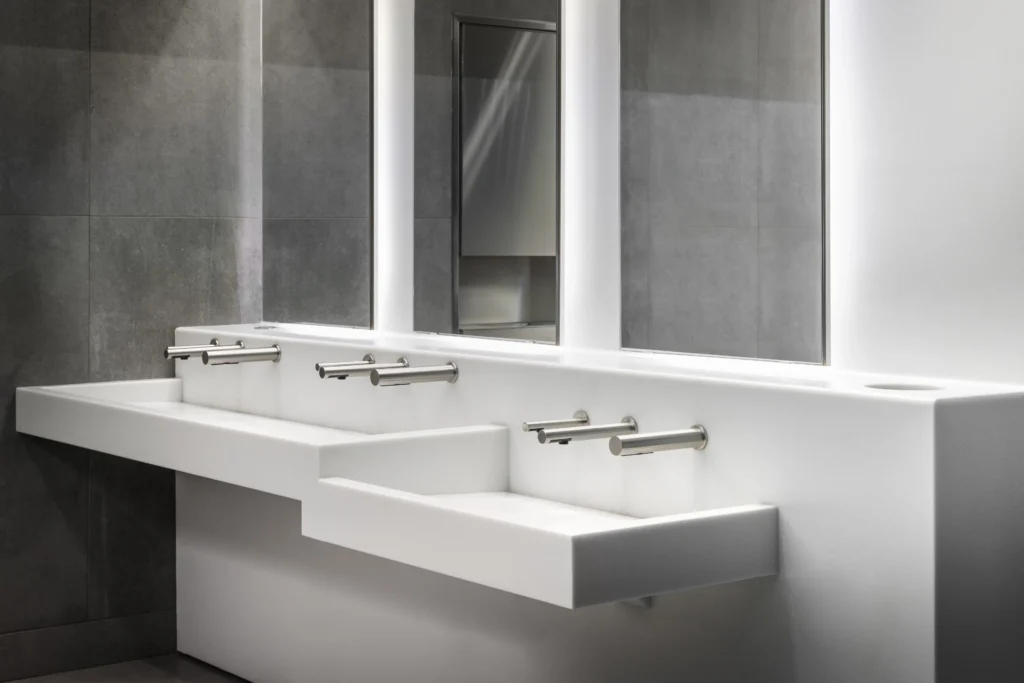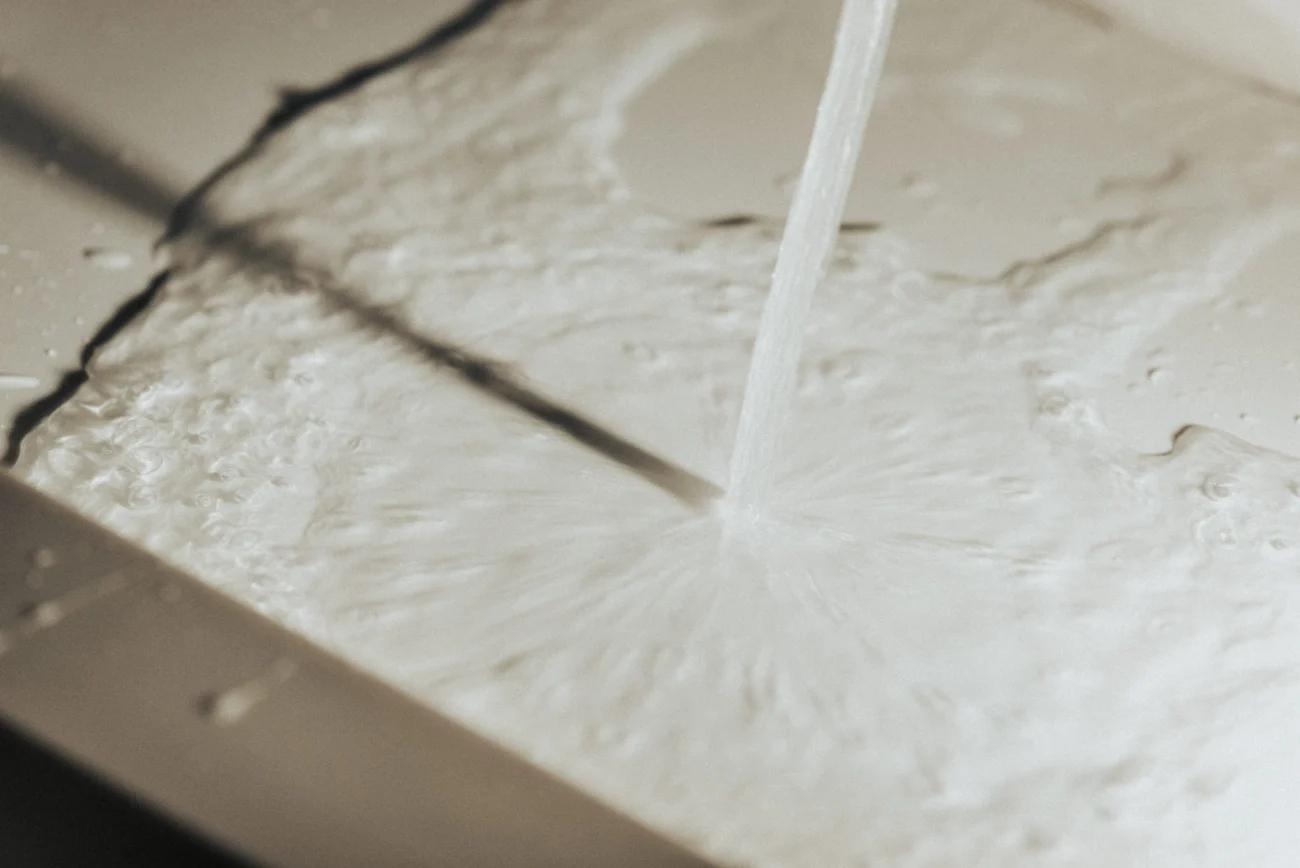Choosing between quartz and solid surface can be quite the design challenge, especially when it comes to specifying sinks for commercial restrooms. They are similar in many aspects, but they differ greatly in the sink models they best suit. Read on to learn which material is the right choice for your next restroom project as we compare and contrast quartz with solid surface material.
Seaming the Monolith Basin in solid surface.
Consequently, sheet size and weight are also distinguishing factors. The largest single sheet of quartz most suppliers offer is between 12 - 13 feet, whereas there’s virtually no limit when it comes to solid surface – since multiple sheets can be connected and refined into one continuous piece. Quartz is also significantly heavier than solid surface, making it more costly to ship and more difficult for industry professionals to install.
 This concept leads to yet another distinguishing factor between quartz and solid surface – modularity. In general, quartz cannot be used to create modular fixtures because each sheet is different as discussed above. There is no uniform texture, tone, weight or sheet size when it comes to quartz, meaning it's nearly impossible to create multiple identical fixtures. This also makes it much more challenging for designers and architects to specify as they have to consider the weight, installation requirements and structural testing of each quartz sheet.
Engineered solid surface material avoids these problems entirely as identical sheets and even complete modules can be created in large quantities at once. However, the innate flexibility of solid surface also has its drawbacks. While it is an easy material to work with, inexperienced fabricators may build troughs incorrectly. Elements like water flow, splash area and drainage all must be considered and tested, and can have lasting detrimental impacts if not designed properly. This commonly occurs with fabricators that create one-off solid surface sinks.
As an exclusive designer and manufacturer of restroom fixtures, our solid surface sinks are carefully crafted to the highest standards of function and compliance. The Monolith and Aerofoil basins are excellent examples of complete solid surface basin systems that consider even the smallest design details. Projects like our collaboration with Dallas Fort Worth Airport showcase these design considerations in action.
This concept leads to yet another distinguishing factor between quartz and solid surface – modularity. In general, quartz cannot be used to create modular fixtures because each sheet is different as discussed above. There is no uniform texture, tone, weight or sheet size when it comes to quartz, meaning it's nearly impossible to create multiple identical fixtures. This also makes it much more challenging for designers and architects to specify as they have to consider the weight, installation requirements and structural testing of each quartz sheet.
Engineered solid surface material avoids these problems entirely as identical sheets and even complete modules can be created in large quantities at once. However, the innate flexibility of solid surface also has its drawbacks. While it is an easy material to work with, inexperienced fabricators may build troughs incorrectly. Elements like water flow, splash area and drainage all must be considered and tested, and can have lasting detrimental impacts if not designed properly. This commonly occurs with fabricators that create one-off solid surface sinks.
As an exclusive designer and manufacturer of restroom fixtures, our solid surface sinks are carefully crafted to the highest standards of function and compliance. The Monolith and Aerofoil basins are excellent examples of complete solid surface basin systems that consider even the smallest design details. Projects like our collaboration with Dallas Fort Worth Airport showcase these design considerations in action.
 In this project, our Monolith C Series was specified in two-user modules for the restrooms in Terminal D South to create functional and code-compliant spaces that were replicated in both male and female restrooms. Everything from the countertops to the basins and pipe skirts work together to create complete units that are extremely durable, easy to maintain and are much more cost-effective for a high-traffic environment like this. Learn more about how we help architects navigate airport restroom design.
In this project, our Monolith C Series was specified in two-user modules for the restrooms in Terminal D South to create functional and code-compliant spaces that were replicated in both male and female restrooms. Everything from the countertops to the basins and pipe skirts work together to create complete units that are extremely durable, easy to maintain and are much more cost-effective for a high-traffic environment like this. Learn more about how we help architects navigate airport restroom design.
The basics
Before we delve into the design differences between solid surface and quartz, we must first understand the basics of each material. Solid surface is a man-made material constructed from several other materials. Originally engineered by Dupont under the name Corian, it was designed to be sleek, durable, pliable and cost-effective. Solid surface can be bent, formed and molded – making it an extremely flexible material that can be used to satisfy a wide range of design needs. Quartz on the other hand is a natural, stone-like material that's very rigid and hard. From a manufacturing standpoint, producing and refining quartz is much more intensive. Though quartz is naturally durable and tough, its inherent benefits and naturalistic feel do carry a higher price point. Its strength also limits the design possibilities and applications as it cannot be shaped or molded. The most distinct difference between quartz and solid surface is their ability to "seam". That is, to connect multiple pieces together. For example, the flexibility of solid surface allows two pieces to be connected together and sanded down into one continuous, seamless piece. The same cannot be said about quartz because each sheet of quartz is slightly different and unique. Connecting two sheets of quartz will not create the same seamless appeal as solid surface, as there will always be some variance between the two sheets.Design & construction
Being a natural material, quartz is generally seen as a more authentic or premium material by designers and architects. This is very important when designing for upscale spaces or interior styles that demand a more natural feel. When choosing between quartz and solid surface, it's really about the architect or designer’s overall vision. Solid surface lends itself to a more continuous feel which is ideal for high-traffic environments, while the more bespoke nature of quartz is better suited to smaller, upscale spaces. This is because a solid surface basin, undermount or countermount, countertop and even pipe skirt can be molded into one seamless unit while a quartz countertop would require different materials for each. This concept leads to yet another distinguishing factor between quartz and solid surface – modularity. In general, quartz cannot be used to create modular fixtures because each sheet is different as discussed above. There is no uniform texture, tone, weight or sheet size when it comes to quartz, meaning it's nearly impossible to create multiple identical fixtures. This also makes it much more challenging for designers and architects to specify as they have to consider the weight, installation requirements and structural testing of each quartz sheet.
Engineered solid surface material avoids these problems entirely as identical sheets and even complete modules can be created in large quantities at once. However, the innate flexibility of solid surface also has its drawbacks. While it is an easy material to work with, inexperienced fabricators may build troughs incorrectly. Elements like water flow, splash area and drainage all must be considered and tested, and can have lasting detrimental impacts if not designed properly. This commonly occurs with fabricators that create one-off solid surface sinks.
As an exclusive designer and manufacturer of restroom fixtures, our solid surface sinks are carefully crafted to the highest standards of function and compliance. The Monolith and Aerofoil basins are excellent examples of complete solid surface basin systems that consider even the smallest design details. Projects like our collaboration with Dallas Fort Worth Airport showcase these design considerations in action.
This concept leads to yet another distinguishing factor between quartz and solid surface – modularity. In general, quartz cannot be used to create modular fixtures because each sheet is different as discussed above. There is no uniform texture, tone, weight or sheet size when it comes to quartz, meaning it's nearly impossible to create multiple identical fixtures. This also makes it much more challenging for designers and architects to specify as they have to consider the weight, installation requirements and structural testing of each quartz sheet.
Engineered solid surface material avoids these problems entirely as identical sheets and even complete modules can be created in large quantities at once. However, the innate flexibility of solid surface also has its drawbacks. While it is an easy material to work with, inexperienced fabricators may build troughs incorrectly. Elements like water flow, splash area and drainage all must be considered and tested, and can have lasting detrimental impacts if not designed properly. This commonly occurs with fabricators that create one-off solid surface sinks.
As an exclusive designer and manufacturer of restroom fixtures, our solid surface sinks are carefully crafted to the highest standards of function and compliance. The Monolith and Aerofoil basins are excellent examples of complete solid surface basin systems that consider even the smallest design details. Projects like our collaboration with Dallas Fort Worth Airport showcase these design considerations in action.
 In this project, our Monolith C Series was specified in two-user modules for the restrooms in Terminal D South to create functional and code-compliant spaces that were replicated in both male and female restrooms. Everything from the countertops to the basins and pipe skirts work together to create complete units that are extremely durable, easy to maintain and are much more cost-effective for a high-traffic environment like this. Learn more about how we help architects navigate airport restroom design.
In this project, our Monolith C Series was specified in two-user modules for the restrooms in Terminal D South to create functional and code-compliant spaces that were replicated in both male and female restrooms. Everything from the countertops to the basins and pipe skirts work together to create complete units that are extremely durable, easy to maintain and are much more cost-effective for a high-traffic environment like this. Learn more about how we help architects navigate airport restroom design.
